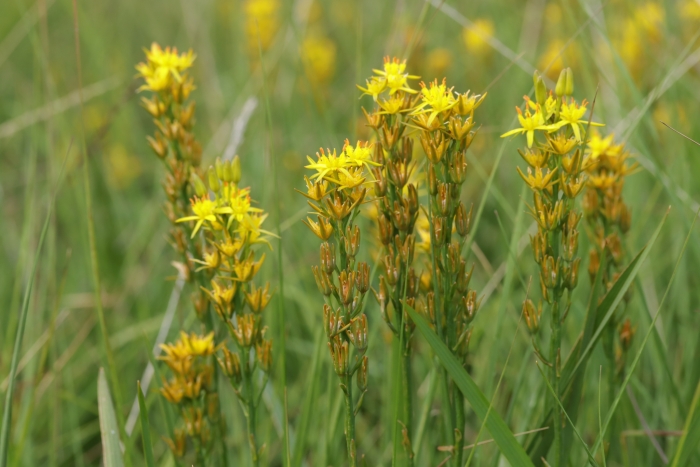Bog Asphodel
(Narthecium ossifragum)
Bog Asphodel (Narthecium ossifragum)
/
/

bjoerns
CC BY-SA 4.0
Image By:
bjoerns
Recorded By:
Copyright:
CC BY-SA 4.0
Copyright Notice:
Photo by: bjoerns | License Type: CC BY-SA 4.0 | License URL: http://creativecommons.org/licenses/by-sa/4.0/ | Rights Holder: bjoerns | Publisher: iNaturalist | Date Created: 2023-07-19T15:34:32-07:00 |

























Estimated Native Range
Summary
Narthecium ossifragum, commonly known as bog asphodel or Lancashire asphodel, is a perennial herb native to acidic, nutrient-poor wetlands, including blanket bogs, wet heaths, and flushes in Western Europe. It is particularly associated with regions like Scotland, Northwest England, Wales, Southwest England, and most of Ireland, and can be found up to about 3,300 feet in elevation. Bog asphodel typically grows to a height of 10-30 cm and features narrow, grass-like leaves. During the summer, it produces racemes of bright yellow, star-like flowers that are highly attractive to pollinators. Following the flowering period, the plant bears deep orange fruits, which add visual interest to the landscape even after the blooms have faded.
Bog asphodel is valued for its vibrant flowers and ability to thrive in challenging wetland environments. It is often used in the creation of bog gardens and for ecological restoration projects where its preference for acidic low-calcium soils and wet conditions is an asset. While it is not a major garden plant, its unique appearance and habitat requirements make it a subject of interest for native plant enthusiasts and those looking to support wetland biodiversity. In cultivation, it requires consistent moisture and can tolerate full sun to part shade. However, gardeners should be aware that the plant can cause photosensitization in grazing animals, leading to a condition known as alveld in sheep.CC BY-SA 4.0
Bog asphodel is valued for its vibrant flowers and ability to thrive in challenging wetland environments. It is often used in the creation of bog gardens and for ecological restoration projects where its preference for acidic low-calcium soils and wet conditions is an asset. While it is not a major garden plant, its unique appearance and habitat requirements make it a subject of interest for native plant enthusiasts and those looking to support wetland biodiversity. In cultivation, it requires consistent moisture and can tolerate full sun to part shade. However, gardeners should be aware that the plant can cause photosensitization in grazing animals, leading to a condition known as alveld in sheep.CC BY-SA 4.0
Plant Description
- Plant Type: Herb
- Height: 1-1.5 feet
- Width: 0.5-1 feet
- Growth Rate: Slow
- Flower Color: Yellow
- Flowering Season: Summer
- Leaf Retention: Evergreen
Growth Requirements
- Sun: Full Sun, Part Shade
- Water: High
- Drainage: Standing
Common Uses
Bee Garden, Bird Garden, Butterfly Garden, Deer Resistant, Low Maintenance, Water Garden
Natural Habitat
Acidic, nutrient-poor wetlands, including blanket bogs, wet heaths, and flushes
Other Names
Common Names: Yellow Asphodel, Bone-Breaker, Rome
Scientific Names: , Narthecium ossifragum, Abama ossifraga, Anthericum ossifragum, Anthericum palustre, Narthecium anthericoides, Narthecium anthericoides, Narthecium gautieri, Narthecium palustre, Phalangium ossifragum
GBIF Accepted Name: